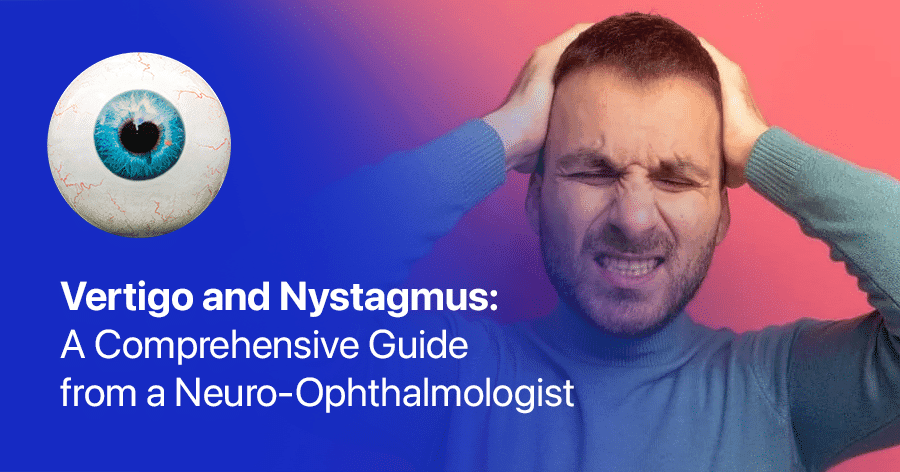
Downbeat Nystagmus: Understanding This Unique Eye Movement Disorder
Downbeat nystagmus is a distinct form of eye movement disorder that can significantly impact an individual’s vision and quality of life. As a neuro-ophthalmologist specializing in nystagmus, I’ve treated numerous patients with this condition. This article aims to provide a comprehensive overview of downbeat nystagmus, its causes, symptoms, and available treatment options.
What is Downbeat Nystagmus?
Downbeat nystagmus is characterized by involuntary eye movements where the eyes drift slowly upward and then quickly correct downward. This repetitive motion can cause various visual disturbances and balance issues.
How does Downbeat Nystagmus occur?
To understand this eye movement disorder, we need to know a few key points:
- Naming: Although it’s called “downbeat,” the problem is actually with the upward eye movement. We name it for the fast downward correction, not the slow upward drift that causes the issue.
- Basic process:
- The eyes slowly drift upward (this is the problem)
- Then they quickly move back down (this is the normal correction)
- How it happens:
- Normally, your inner ear tells your brain how your head is moving
- Your brain then tells your eye muscles how to move to keep your vision steady
- Part of your brain called the cerebellum (specifically the flocculus) helps control this process
- What goes wrong:
- There’s a problem with the connection between the brainstem and cerebellum
- This causes a mix-up in the signals sent to the eye muscles
- As a result, the eyes drift upward when they shouldn’t
- The brain then has to keep correcting this upward drift, causing the downbeat nystagmus
- Location of the problem:
- The issue usually comes from a specific area where the brain and spinal cord meet (called the cervical medullary junction)
- This area contains important nerve cells that help coordinate eye movements
In simple terms, downbeat nystagmus happens because of a communication problem in the brain. This causes the eyes to drift up slowly, followed by a quick downward correction. The condition is named for this quick downward movement, even though the upward drift is the actual problem.
Causes of Downbeat Nystagmus
Understanding the underlying causes of downbeat nystagmus is crucial for effective diagnosis and treatment. Several factors can contribute to the development of this condition:
- Cerebellar Dysfunction: The most common cause, often related to:
- Arnold-Chiari malformation
- Cerebellar degeneration
- Stroke or tumors affecting the cerebellum
- Medication Side Effects: Certain drugs can induce downbeat nystagmus, including:
- Anticonvulsants (e.g., phenytoin, carbamazepine)
- Lithium
- Some antidepressants
- Metabolic Disorders:
- Wernicke’s encephalopathy
- Magnesium deficiency
- Neurodegenerative Diseases:
- Multiple sclerosis
- Parkinson’s disease
- Vestibular System Disorders:
- Vestibular neuritis
- Meniere’s disease
Symptoms and Impact of Downbeat Nystagmus
Patients with downbeat nystagmus often experience a range of symptoms that can significantly affect their daily lives:
- Oscillopsia (perception of environment moving up and down)
- Blurred or double vision
- Difficulty with reading or close-up tasks
- Balance problems and dizziness
- Neck pain or stiffness (due to compensatory head positioning)
These symptoms can lead to challenges in work, education, and social interactions, underscoring the importance of proper diagnosis and management.
Diagnosis of Downbeat Nystagmus
Accurate diagnosis of downbeat nystagmus involves a comprehensive eye examination and neurological assessment:
- Visual Acuity Testing: To assess the impact on vision
- Eye Movement Examination: Using specialized equipment like videonystagmography
- Neurological Evaluation: To check for underlying cerebellar or brainstem issues
- Imaging Studies: MRI or CT scans to identify structural abnormalities
- Blood Tests: To rule out metabolic causes
Treatment Options for Downbeat Nystagmus
While downbeat nystagmus can be challenging to treat, several options are available to manage symptoms and improve quality of life:
Medications
- 4-Aminopyridine: A potassium channel blocker that has shown effectiveness in reducing nystagmus
- Clonazepam: Can help in some cases, particularly those related to cerebellar dysfunction
- Baclofen: May be beneficial, especially in combination with other treatments
Non-Pharmacological Approaches
- Vision Therapy: Exercises to improve gaze stability and visual function
- Prism Glasses: Can help compensate for abnormal eye positioning
- Adaptive Strategies: Teaching patients techniques to minimize visual disturbances
Surgical Interventions
In select cases, surgical procedures may be considered:
- Strabismus surgery to realign the eyes
- Procedures to treat underlying conditions (e.g., decompression for Chiari malformation)
Living with Downbeat Nystagmus: Coping Strategies and Support
Managing downbeat nystagmus extends beyond medical treatments. Patients can benefit from:
- Occupational Therapy: To adapt work and home environments
- Support Groups: Connecting with others who have similar experiences
- Regular Follow-ups: Monitoring progression and adjusting treatment as needed
- Lifestyle Modifications: Such as avoiding triggers that worsen symptoms
Stay Informed with “The Nystagmus Book”
If you’re looking to deepen your understanding of nystagmus and stay up-to-date with the latest research and management strategies, I invite you to check out my book, “The Nystagmus Book.” This comprehensive guide contains all the legitimate, up-to-date information about nystagmus as of 2024, including the most recent research findings and best practices for managing the condition.
In a world where misleading information about nystagmus is unfortunately common, “The Nystagmus Book” offers a reliable, science-based resource. It’s packed with practical tips, the latest treatment options, and insights from my 20+ years of research in the field. Whether you’re living with nystagmus, caring for someone who is, or simply want to learn more about this condition, this book is an invaluable resource.




